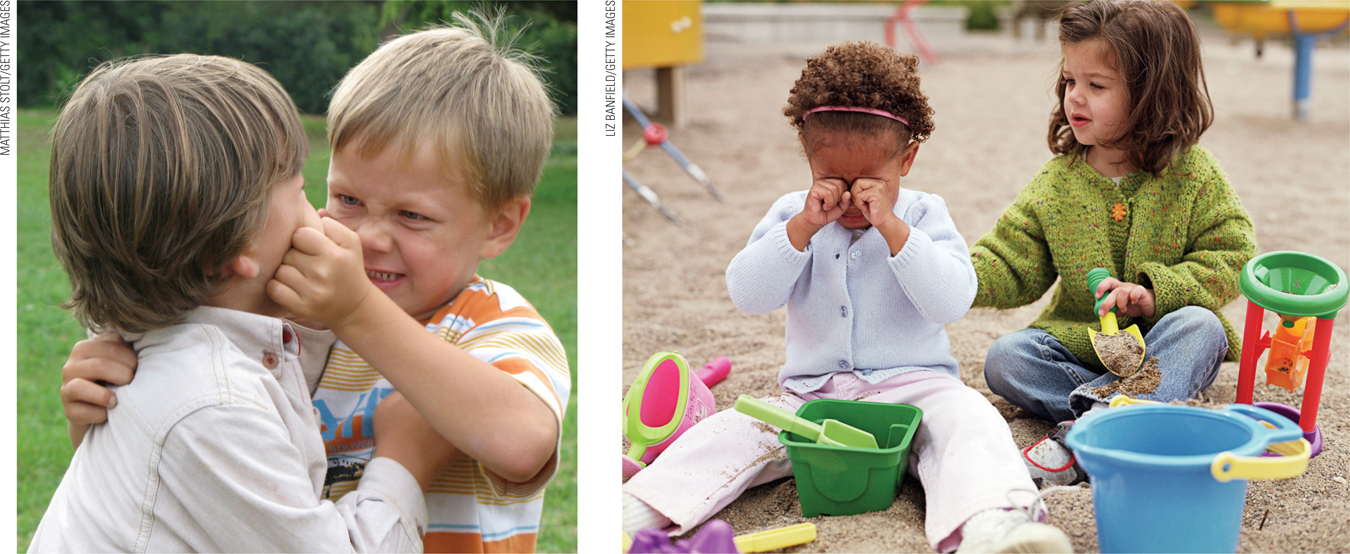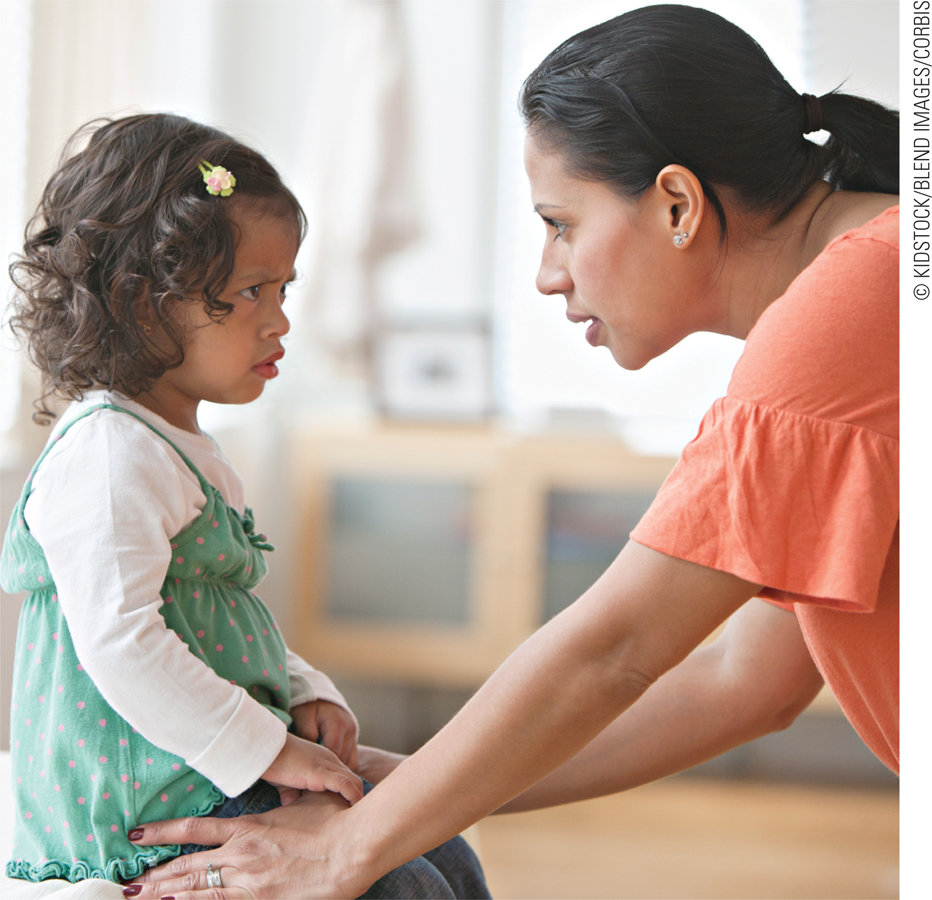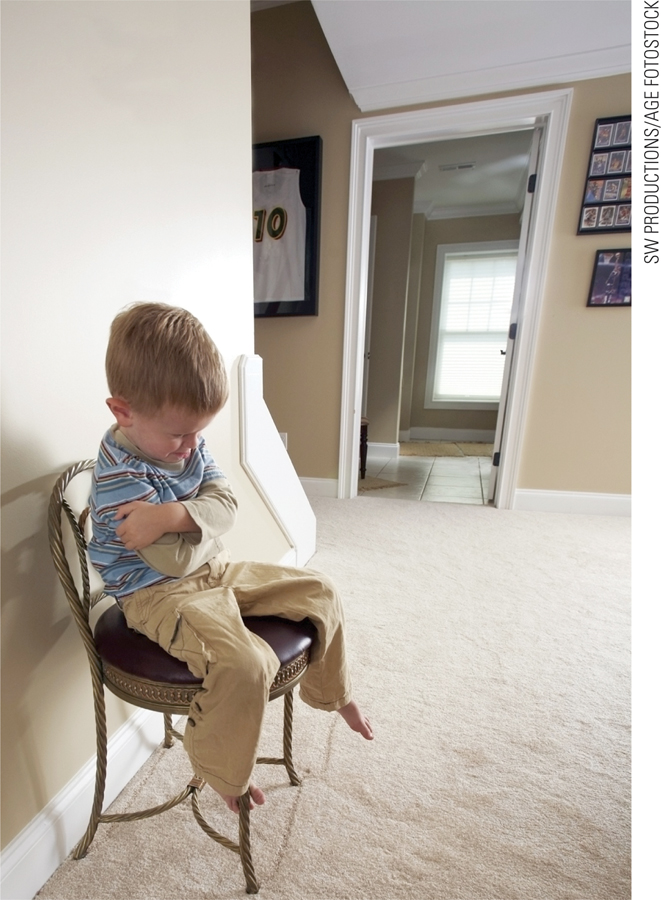Moral Development
Children develop increasingly complex moral values, judgments, and behaviors as they mature. Emotional regulation, sexual differences, and parenting practices are all moral issues, as “morality is multifaceted and includes affective, cognitive, and behavioral components” (Smetana, 2013). Thus, moral development is evident in every topic already discussed.


Video: Interview with Lawrence Walker discusses what parents can do to encourage their children’s moral development.
Rough-
Piaget thought that moral development began when children learned games with rules, which he connected with concrete operational thought at about age 7 (Piaget, 1932/2013). We now know that Piaget was mistaken: Both games with rules and moral development are evident much earlier.
Some precursors of morality appear in infancy (Narvaez & Lapsley, 2009). By age 3 or even earlier, children evidence many moral emotions and behaviors. For example, when given rewards to distribute, 3-
With maturation and adult guidance over the preschool years, children develop guilt (as Erikson explained) and self-
Nature and Nurture
Many parents, teachers, and other adults consider children’s “good” behavior more important than any other advancement already described, including health, motor skills, intelligence, language, and social play. Perhaps for this reason, debate rages over how children internalize standards, develop virtues, and avoid vices. Scholars in many social sciences hold conflicting perspectives—
The nature perspective suggests that morality is genetic, an outgrowth of natural bonding, attachment, and cognitive maturation. That would explain why young children help and defend their parents, no matter what the parents do, and punish other children who violate moral rules. Even infants have a sense of what is fair and not, expecting adults to reward effort. An experiment with 6-
Morality, if defined as behavior that helps others without immediate reward to oneself, may be in human DNA. According to evolutionary theory, humans protect, cooperate, and even sacrifice for one another because each individual is defenseless and vulnerable to weather, strangers, and wild animals. To survive, people need to rely on other people, and from that need springs a moral sense (Dunning, 2011). The body produces hormones, specifically oxytocin, that naturally push people toward trusting and loving each other (Zak, 2012).
The nurture perspective contends that culture is crucial to moral development. That would explain why young children emulate people who follow the rules of their community, even if the actual behavior is not innately good or bad. Although children understand the intellectual difference between morality and custom, some children believe that people who eat raw fish, or hamburgers, or bacon, or dogs are immoral (Turiel, 2002).
Developmentalists distinguish between ethical behavior (seeking not to harm others) and conventional behavior (seeking to follow norms), but that distinction is not always apparent, and may itself be cultural (Haidt, 2013). Consider gun use, abortion, the death penalty, disobeying an elder, stealing food—
Both nature and nurture are influential in standards of conduct, and the interaction between the two is essential—
However, it is apparent that morality appears during early childhood and that parental practices are crucial as they teach children—
Empathy and Antipathy
Moral emotions are evident as children play with one another. With increasing social experiences and decreasing egocentrism, children develop empathy, an understanding of other people’s feelings and concerns, and antipathy, a feeling of dislike or even hatred. Experience is crucial at every age; people with more friends of various backgrounds are more empathetic to those of another race or immigration status.
Prosocial Behavior
Scientists studying young humans and other primates report spontaneous efforts to help others who are hurt, crying, or in need of help: Those efforts are evidence of empathy and compassion, which then lead to prosocial behavior—extending helpfulness and kindness without any obvious benefit to oneself.
Expressing concern, offering to share, and including a shy child in a game or conversation are examples of prosocial behavior among young children. Jack, age 3, showed empathy when he “refused to bring snacks with peanuts to school because another boy had to sit alone during snack because he was allergic to nuts. Jack wanted to sit with him” (Lovecky, 2009, p. 161).
Prosocial behavior seems to result more from emotion than from intellect, more from empathy than from theory of mind (Eggum et al., 2011). The origins of prosocial behavior may arise from parents helping their children become aware of their own emotions, not from telling children what emotions others might have (Brownell et al., 2013).
The link between empathy and later prosocial behavior in early childhood was traced longitudinally in children from 18 months to 6 years of age. A preschooler’s empathy at ages 2 to 4 predicted prosocial behavior in first grade: Those empathetic preschoolers were more likely to share help, and include other children. Neither parents’ education nor income predicted prosocial behavior (Taylor et al., 2013).
Prosocial reactions are not automatic. Some children limit empathy by “avoiding contact with the person in need [which illustrates] … the importance of emotion development and regulation in the development of prosocial behavior” and the critical influence of cultural norms (Trommsdorff & Cole, 2011, p. 136). Feeling distress may be a part of nature; whether a child expresses that emotion, and how a child responds to his or her feelings of distress, may be nurture.
Antisocial Actions
Antipathy can lead to antisocial behavior—deliberately hurting another person, including people who have done nothing wrong. Antisocial actions include verbal insults, social exclusion, and physical assaults (Calkins & Keane, 2009). An antisocial 4-

In some ways, antisocial behavior comes naturally (Seguin & Tremblay, 2013). For 2-
At every age, antisocial behavior may indicate a failure of empathy. That may be brain-
Aggression
Not surprisingly, given the moral sensibilities of young children, 5-
As with adults, impulsive self-
Researchers recognize four general types of aggression, all of which are evident in early childhood (see Table 10.2). Instrumental aggression is common among 2-

Reactive aggression is therefore common among young children; almost every child reacts when hurt, whether or not the hurt was deliberate. Children are less likely to respond with physical aggression as they develop emotional control and theory of mind (Olson et al., 2011).
Relational aggression (usually verbal) destroys another child’s self-
The fourth and most ominous type is bullying aggression, done to dominate someone else. It is not rare among young children but should be stopped before school age, when it becomes particularly destructive. Not only does it destroy the self-
All forms of aggression become less common from ages 2 to 6, as the brain matures and empathy increases. In addition, children learn to use aggression selectively, and that decreases both victimization and aggression later on (Ostrov et al., 2014). Parents, peers, and preschool teachers are pivotal mentors in this process.
It is a mistake to expect children to regulate their emotions on their own. If they are not guided, they may develop destructive patterns. It is also a mistake to punish aggressors too harshly because that may remove them from their zone of proximal development, where they can learn to regulate their anger.
In other words, although there is evidence that preschool children spontaneously judge others who harm people, with the emphasis on the actual hurt more than the intention, there also is evidence that prosocial and antisocial behavior is learned (Smetana, 2013). Preschool teachers are often instrumental in this education because they have many opportunities to teach: Aggression often arises in a social setting with other children.
A longitudinal study found that close teacher–
Good Behavior
For people everywhere, part of human development is learning the moral standards of their culture. Each culture has particular moral principles; parents form personal standards based on these principle and then guide their children in developing good behavior.
However, no child always does exactly what parents want. Indeed, if a child is too quiet and proper, that may be a sign that the child is fearful of a parent’s rage. Some disagreements, some protests, some untoward impulses and unexpected rebellion are part of the normal process of growing up.
Lest anyone imagine that children will always be good if they have benevolent parents, consider a study of mothers and 3-
Child:
I want my other shoes.
Mother:
You don’t need your other shoes. You wear your Pooh sandals when we go for a walk.
Child:
Noooooo.
Mother:
[Child’s name]! You don’t need your other shoes.
Child:
[Cries loudly]
Mother:
No, you don’t need your other shoes. You wear your Pooh sandals when we go for a walk.
Child:
Ahhhh. Want pretty dress. [Crying]
Mother:
Your pretty dress!
Child:
Yeah.
Mother:
You can wear them some other day.
Child:
Noooooo. [Crying]
[from Laible et al., 2008, pp. 442–
Especially for Parents of 3-
Remember, authoritative parents listen but do not usually give in. A parent could ask why the child did not want the Pooh sandals (ugly? too tight? old?) and explain why the “other shoes” were not appropriate (raining? save for special occasions? hard to walk in?). A promise for the future (e.g., “Let’s save your other shoes and pretty dress for the birthday party tomorrow”) might stop the “Noooo.”
In this study, those 3-
However, unlike the situation in the snippet above, the mothers of securely attached children more often compromised and explained (Laible et al., 2008). Is that the best response? Should this mother have offered reasons why the other shoes were not appropriate, or should she have let her daughter wear them? Alternatively, should she have slapped the child for crying, or said, “I won’t walk with you if you fuss”?
Discipline
Since misbehavior is part of growing up, parents must respond. How to respond is a major moral issue for the parents, with each type of response teaching the child something about moral behavior.
Physical Punishment
Especially for Parents Suppose you agree that spanking is destructive, but you sometimes get so angry at your child’s behavior that you hit him or her. Is your reaction appropriate?
No. The worst time to spank a child is when you are angry. You might seriously hurt the child, and the child will associate anger with violence. You would do better to learn to control your anger and develop other strategies for discipline and for prevention of misbehavior.
In the United States, young children are slapped, spanked, or beaten more often than are infants or older children. They are physically disciplined more often than children in Canada or Western Europe but less often than children in Africa or South America. Not only in the United States but also in many developing nations, adults remember being physically punished and think it works. In some ways, they are correct: Physical punishment (called corporal punishment because it hurts the body) succeeds at the moment—
Longitudinal research finds, however, that children who are physically punished are more likely to become bullies, delinquents, and then abusive adults. They are also less likely to learn quickly in school or attend college (Straus & Paschall, 2009). In fact, although children who misbehave in externalizing ways (hitting, yelling, throwing things) are more likely to be spanked, longitudinal research finds that children who are not spanked are more likely to learn self-

In 33 nations (mostly in Europe), corporal punishment is illegal; in many nations on other continents, it is the norm. In the United States, parents use it often. Even in U.S. schools, paddling is legal (but rarely used) in 19 of the 50 states. Most of those states are in the Southeast, and most of the children who are paddled are African American boys, which raises questions about the justice of the punishment (Morones, 2013).
Although some adults believe that physical punishment will “teach a lesson” of obedience, the lesson that children learn may be that “might makes right.” When they become bigger and stronger, children who have been physically disciplined then tend to use corporal punishment on others—
opposing perspectives
Is Spanking Okay?
Opinions about spanking are influenced by past experiences and cultural norms, making it hard for opposing perspectives to be understood by people on the other side (Ferguson, 2013).
What might be right with spanking? One argument is that over the centuries many parents have done it, so it has stood the test of time. Indeed, spanking is probably the most common punishment in the United States: One study found that 85% of United States teenagers remember being slapped or spanked by their mothers (Bender et al., 2007).
Another argument is that the correlations often reported between spanking and later depression, crime, low achievement, and so on may reflect SES differences, not spanking. As you remember from Chapter 1, sometimes a correlation is the result of a third variable, which is the cause of both of the two variables that correlate. Since people who do not spank their children tend have more education than people who do, SES may be the real reason children who are not spanked tend to do better in school. A study that attempted to parcel out all the possible third variables between punishment style and later development found a much smaller correlation between spanking and future problems than most other studies report (Ferguson, 2013).
What might be wrong with spanking? One problem is the emotions of the adult, as angry spankers sometimes become abusive. Another problem is the child’s cognition. Many children do not understand the reason behind the spanking. Parents assume the transgression is obvious, but many children think the parents’ emotions, not the child’s actions, triggered the spanking (Harkness et al., 2011).
Almost all the research finds that children who are spanked continue to suffer in many ways. They are more depressed, more antisocial, more likely to hate school, and less likely to have close friends. While critical thinking demands that we consider all sides until the evidence is clear, one developmentalist says, “We know enough now to stop hitting our children” (Gershof, 2013, p. 133). Most other child advocates agree.
Yet the evidence is not clear enough to satisfy everyone. For example, one study of parents who attend religiously conservative Protestant churches found that, as expected, they spanked their children more often than other parents did. However, unexpectedly, children spanked during early (but not middle) childhood did not develop the lower self-
The authors of the study suggest that, since spanking was the norm, conservative Protestant children do not perceive being spanked as stigmatizing or demeaning. Moreover, spanking may be accompanied by induction: Religious leaders also tell parents to explain transgressions, to assure children that they are loved, and never to spank in anger. As a result, their children may view mild-
As I write these words, I realize that the opposing perspective is mine. As you saw in the opening of this chapter, I believe that children should never be hit. I am one of many developmentalists convinced that alternatives to spanking are better for the child as well as a safeguard against abuse.
But a dynamic-
I do not think children should be spanked. Yet I know that I am influenced by my background and context; I also know that I am not always right. Whatever your opinion, consider the alternatives.

Many studies of children from all family constellations find that physical punishment of young children correlates with delayed theory of mind and increased aggression (Olson et al., 2011). To prove cause without a doubt would require parents of monozygotic twins to raise them identically, except that one twin would be spanked often and the other never. Of course, that is unethical as well as impossible.
Nonetheless, most developmentalists wonder why parents would take the chance. The best argument in favor of spanking is that alternative punishments may be worse (Larzelere et al., 2010). Let us consider other options.
Psychological Control
A common method of discipline is called psychological control, in which children’s shame, guilt, and gratitude are used to control their behavior (Barber, 2002). Psychological control may reduce academic achievement and emotional understanding, just as spanking is thought to do (Alegre, 2011).
Consider the results of a several studies in Finland, in which parents were asked about psychological control (Aunola et al., 2013). If parents strongly agreed with the following questions, they were considered to use psychological control:
“My child should be aware of how much I have done for him/her.”
“I let my child see how disappointed and shamed I am if he/she misbehaves.”
“My child should be aware of how much I sacrifice for him/her.”
“I expect my child to be grateful and appreciate all the advantages he/she has.”
The higher the parents scored on these four measures of psychological control, the lower the children’s math scores were—
Time-Out and Induction
A disciplinary technique often used with young children in North America is the time-
The crucial idea behind time-
Often combined with the time-
Such conversation helps children internalize standards, but induction takes time and patience. Since 3-
Nonetheless, induction seems to pay off over time. Children whose parents used induction when they were 3 years old became children with fewer externalizing problems in elementary school (Choe et al., 2013b).

SUMMING UP Children’s moral development often advances during early childhood, as they develop empathy while their theory of mind advances and their emotions become better regulated. New empathy usually helps a child act prosocially, making the child able to share, take turns, and so on. Children can also increasingly develop antipathy, another emotion that indicates cognitive advances. All young children are sometimes aggressive, engaging in instrumental (to get something) or reactive aggression. Those who hurt other children without a self-
Parents, guided by their culture, teach morality in many ways. One way is that children learn from parents’ strategies for discipline, sometimes learning the wrong lesson, such as that people who are stronger can hurt other people. Every means of punishment may have long-
WHAT HAVE YOU LEARNED?
Question 10.20
What did Piaget believe about the moral development of children?
Piaget thought that moral development began when children learned games with rules, which he connected with concrete operational thought at about age 7.Question 10.21
How might evolutionary theory explain moral development?
Morality, if defined as behavior that helps others without immediate reward to oneself, may be in our DNA. According to evolutionary theory, humans protect, cooperate, and even sacrifice for one another precisely because our bodies are defenseless against the elements and vulnerable against possible predators. Thus people have long needed to rely on coordination and cooperation with others in order to survive, and from that need springs a moral sense. Hormones, specifically oxytocin, that are produced by the body may naturally push people toward trusting and loving each other.Question 10.22
What is the nature perspective on how people develop morals?
The nature perspective suggests that morality is genetic, an outgrowth of natural bonding, attachment, and cognitive maturation.Question 10.23
What is the nurture perspective on how people develop morals?
The nurture perspective contends that culture is crucial to the development of morality.Question 10.24
How might children develop empathy and antipathy as they play with one another?
With increasing social experiences and decreasing egocentrism, children develop empathy, which is an understanding of other people's feelings and concerns. Some children limit empathy by avoiding contact with the person in need. They may also develop antipathy, which is dislike or even hatred for another.Question 10.25
What is the connection between empathy and prosocial behavior?
Scientists studying young humans and other primates report spontaneous efforts to assist others who are hurt, crying, or in need of help: That is evidence of empathy, which leads to prosocial behavior. Prosocial behaviors are those that offer helpfulness and kindness without any obvious benefit to oneself. Prosocial behavior seems to result more from empathy than from intellect or theory of mind.Question 10.26
What are the four kinds of aggression?
Instrumental aggression is common among 2–year– old children, who often want something they do not have and simply try to take it. Reactive aggression is common among young children; almost every child reacts with aggression when attacked. Relational aggression (usually verbal) destroys another child's self– esteem and disrupts the victim's social networks, becoming more hurtful as children mature. Bullying aggression, done to dominate someone else, is not rare among young children. Question 10.27
How does moral development relate to discipline?
Ideally, adults use discipline to guide children toward internalized standards of morality.Question 10.28
Why have some nations made corporal punishment illegal?
In several European nations, corporal punishment is illegal. Although some adults believe that physical punishment will teach a lesson of obedience, the lesson that children may learn is that “might makes right.” When they become bigger and stronger, they may use corporal punishment on others. Parents who hit were usually hit themselves as children.Question 10.29
How could psychological control be harmful?
A common method of discipline is called psychological control, in which children's shame, guilt, and gratitude are used to control their behavior. Psychological control may reduce academic achievement and emotional understanding, just as spanking is thought to do.Question 10.30
When and how would time-
out and induction be most effective? During time–out, an adult requires a misbehaving child to sit quietly, without toys or playmates, for a short time. This is done instead of yelling at or spanking the child. To be effective, a time– out must be brief; one minute for each year of the child's age is a common suggestion. Induction, in which parents talk extensively to the offender, helps the child to internalize parental standards.